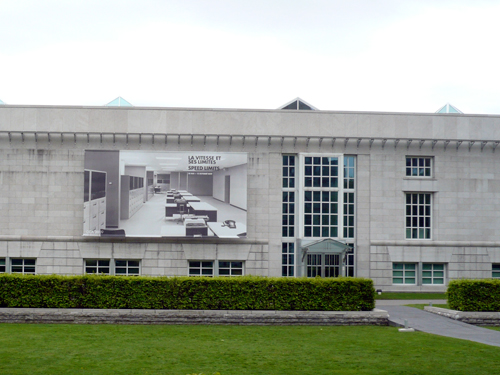
The Speed Limits banner on the façade of Montreal’s Canadian Centre for Architecture (CCA) shows a black and white photograph of a modern office interior, complete with dial telephones, typewriters and file cabinets. This may once have been a showcase of technological and economical progress, a node of the ever busier and more interconnected network of commerce, but it now feels stale, outdated and frozen in time. You can almost hear the white noise of the fluorescent lights and breathe in the asbestos. This picture is the farthest it gets from Filippo Tommaso Marinetti’s dictum “The world’s magnificence has been enriched by a new beauty: the beauty of speed”, published a hundred years ago in his Futurist Manifesto. But that’s why it’s there.
The original 1965 photograph of the North Carolina Mutual Life Insurance Building’s secretary pool can later be found in the fourth of the exhibition’s six rooms. Themed Efficiency, it shows how speed equalled progress, (hiper)productivity and increased well-being in the twentieth century’s two main workspaces: the office and the kitchen. Like other photographs, advertisements and promotional videos from both sides of the iron curtain, it is presented as a testament to a time when the hardest part of baking a cake became adding an egg to the instant mix and Xerox machines were state of the art. It also shows where the Futurists’ exhilaration over speed proclaimed by the applied arts of the avant-garde met the contingent spaces and bodies of the common man. For it was in the gaps found between beauty and boredom, utopia and reality, the heroic and the mediocre, that curator Jeffrey T. Schnapp found a fertile ground for exploring not only modernity’s love affair with speed, but also the many burdens it has caused on the modern world – from our overcrowded cities to our over-stimulated brains.
The collaborative result of three research institutions – the CCA, the Wolfsonian-Florida International University and Stanford University, where Schnapp is the Pierotti Chair in Italian Literature and Humanities Lab founder –, Speed Limits is the latest in CCA’s world-class series of thought-provoking, topical approaches to our designed and built environments. It is also a fine example of a scholarly rigorous, yet (in a nod to Michael Maltzan Architects and graphic designers Project Projects) sensorially captivating show, where successful dialogues between the over 240 historical artefacts and large-scale moving images are established across its themed gallery spaces.
Passenger statistics diagrams and vehicle accident studies encircle the Traffic room’s TV screen centrepiece, where nine cities are navigated at speeds only possible in a virtual, Formula One video game reality. In Fast Construction, architecture is presented as performance in 1920s Sears Roebuck prefab housing catalogues, stop-motion videos showing the erection of the Eiffel and CCTV Towers (at the rate of one week per second) and a selection of demolition methods, of which the Japanese, storey-by-storey “daruma-otoshi” technique is the most mesmerizing. Usain Bolt’s 100-metre sprint World record is broken every 9.69 seconds in one of the walls of Mind and Body, where Eadweard Muybridge’s “Animal Locomotion” studies share counter space with natural, but mostly synthetic, stimulants and sedatives designed to overcome our physical obstacles and mental shortcomings.
A vertiginous car ride and subsequent crash into a Milan ditch may have inspired Marinetti to write his inflammatory manifesto, but there is nothing Crash! Boom! Bang! about Speed Limits. From a photograph of the wrecked vehicle (1908) to a 50-minute excerpt from Andy Warhol’s Empire film (1964) or Kem Weber’s streamlined Zephyr clock (1933), all of the exhibition’s contents are presented stripped of any trace of bravado, irony or nostalgia. By consciously relinquishing to address modern man’s fascination with speed in a celebratory manner, the exhibition detaches itself from other more frenzied commemorations of the manifesto’s centenary, or from celebrating speed for speed’s sake. It does however leave you with the uneasy feeling that everything we consider designed progress may in the future (or even in the present) change gears, slow down or come to a grinding halt – and that is no small accomplishment.
—
I first wrote a 600-word review of Speed Limits for icon magazine in late May of 2009. It ended up being edited down to just over 450 words, losing in my view some of the details that I liked best. In late June I sent my original piece (with a few changes) to the frieze Writer’s Prize, a yearly award for art criticism. I had previously asked the editors of frieze (who don’t usually accept design exhibition reviews) if Speed Limits would be eligible, as it had as starting point Marinetti’s manifesto. They agreed, and I sent it. In late August I got news from Jennifer Higgie, who said I had been selected, among over 300 entries, as one of the jury’ 8 commended writers.